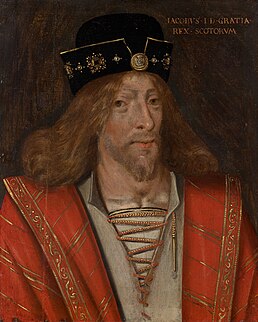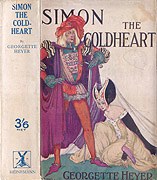This article includes a list of general references, but it lacks sufficient corresponding inline citations .(November 2021) |
Robert Mac Wattin, alias Robert Barrett, Anglo-Irish lord, fl. 1413.
This article includes a list of general references, but it lacks sufficient corresponding inline citations .(November 2021) |
Robert Mac Wattin, alias Robert Barrett, Anglo-Irish lord, fl. 1413.
Mac Wattin was a member of a branch of the Barrett family of north Connacht, descended from a Batin or Wattin Barrett, alive c. 1300. (Knox, p. 121).
According to an entry sub anno 1413 in the Annals of the Four Masters ,
Henry Barrett was taken prisoner in the church of Airech-Locha-Con (Lough Conn) by Mac Wattin (i.e. Robert), who carried him away by force, after profaning the place. But Mac Wattin passed not a night in which the saint of the place (Tigearnan of Airech) did not appear to him in a vision, demanding the prisoner, until he obtained his request at last; and Mac Wattin granted a quarter of land to Tighearnan Airich for ever, as an eric for having violated him.
Knox lists him as a son of Henry Mer Mac Wattin (died 1399), making him a great-great grandson of Batin Barrett. Robert's great-grandson, Richard, would become Bishop of Killala.

John Knox, born was a Scottish minister, Reformed theologian, and writer who was a leader of the country's Reformation. He was the founder of the Presbyterian Church of Scotland.

Henry V, also called Henry of Monmouth, was King of England and Lord of Ireland from 1413 until his death in 1422. Despite his relatively short reign, Henry's outstanding military successes in the Hundred Years' War against France made England one of the strongest military powers in Europe. Immortalised in Shakespeare's "Henriad" plays, Henry is known and celebrated as one of the greatest warrior-kings of medieval England.

Henry IV, also known as Henry Bolingbroke, was King of England from 1399 to 1413. He asserted the claim of his grandfather King Edward III, a maternal grandson of Philip IV of France, to the Kingdom of France. Henry was the first English ruler since the Norman Conquest, over three hundred years prior, whose mother tongue was English rather than French.

James I was King of Scots from 1406 until his assassination in 1437. The youngest of three sons, he was born in Dunfermline Abbey to King Robert III and his wife Annabella Drummond. His older brother David, Duke of Rothesay, died under suspicious circumstances while being detained by their uncle, Robert, Duke of Albany. His other brother, Robert, died young. Fears for James's safety grew through the winter of 1405/6 and plans were made to send him to France. In February 1406, James was forced to take refuge in the castle of the Bass Rock in the Firth of Forth after his escort was attacked by supporters of Archibald, 4th Earl of Douglas. He remained there until mid-March, when he boarded a vessel bound for France. On 22 March English pirates captured the ship and delivered the prince to Henry IV of England. The ailing Robert III died on 4 April and the 11-year-old James, now the uncrowned King of Scots, would not regain his freedom for another eighteen years.

The Dukedom of Lancaster is an extinct English peerage. It was created three times during the Middle Ages but finally merged in the Crown when Henry V succeeded to the throne in 1413. Despite the extinction of the dukedom the title has continued to be used to refer to the reigning monarch of the United Kingdom in relation to the County Palatine of Lancaster and the Duchy of Lancaster, an estate held separately from the Crown Estate for the benefit of the sovereign.

Henry Knox, a Founding Father of the United States, was a senior general of the Continental Army during the Revolutionary War and was appointed the first Secretary of War under the U.S. Constitution by president George Washington, serving from 1789 to 1794. During the war, he directed the artillery in most of Washington's campaigns, who appointed him first Secretary of War from 1789—1794. He initially oversaw the War Department as secretary under the Articles of Confederation, 1785—1789. He is perhaps best known today as the namesake of Fort Knox in Kentucky, the repository of a large portion of the nation's gold reserves.

Execution by elephant was a common method of capital punishment in South and Southeast Asia, particularly in India, where Asian elephants were used to crush, dismember or torture captives in public executions. The animals were trained and versatile, able to kill victims immediately or to torture them slowly over a prolonged period. Most commonly employed by royalty, the elephants were used to signify both the ruler's absolute power and his ability to control wild animals.

Baron Dacre is a title that has been created three times in the Peerage of England, every time by writ.

Sir William Gascoigne was Chief Justice of England during the reign of King Henry IV.

Robert Knox was a Scottish anatomist and ethnologist best known for his involvement in the Burke and Hare murders. Born in Edinburgh, Scotland, Knox eventually partnered with anatomist and former teacher John Barclay and became a lecturer on anatomy in the city, where he introduced the theory of transcendental anatomy. However, Knox's incautious methods of obtaining cadavers for dissection before the passage of the Anatomy Act 1832 and disagreements with professional colleagues ruined his career in Scotland. Following these developments, he moved to London, though this did not revive his career.

Clan Drummond is a Highland Scottish clan. The surname is rendered "Druimeanach" in modern Scottish Gaelic.
Clan Sweeney is an Irish clan of Scottish origin. The Mac Suibhne family did not permanently settle in Ireland before the beginning of the 14th century, when they became Gallowglass soldiers for the Ua Domnaill dynasty of Tír Chonaill. The clan also claims an Irish descent from a prince of the Uí Néill dynasty, Ánrothán Ua Néill, son of Áed, son of Flaithbertach Ua Néill, King of Ailech and Cenél nEógain, died 1036. Through this descent the clan can claim a descent from Niall Noigíallach.

Simon the Coldheart is a historical fiction novel by Georgette Heyer published in 1925. Not a typical Georgie Heyer regency story, it is a tale of chivalry, intrigue and conquest. Set in the medieval period during the Hundred Years' War between England and France, it is her fifth novel, and the first of only three set in that period.
Prehen is a small townland and estate outside the city of Derry, County Londonderry, Northern Ireland. The estate is located in the Prehen and Brickkilns townland. Roads in the Prehen area consist of Victoria road, Prehen Park, Corrody Road and Woodside Road. The estate is located between Derry city and Newbuildings just off the A5 and is accessible this way while the townland is located on the eastern part of the City Of Derry Golf Course and part of the Woodside Road.
Clan Barrett is an Irish clan from County Cork that originally descended from Norman invaders who travelled through England and Wales with William the Conqueror in the 12th century, and then into Ireland with Strongbow in the 13th century. They are often thought to be related to the ancestors of the similarly-named Clan Barrett of the mountainous Mayo-Galway areas, who are otherwise considered Gaelic in origin. Of the two, the Cork branch was considered numerically stronger, while the Mayo-Galway branch held more prominence in the Middle Ages.
Amlaíb Cenncairech was a Norse ruler and presumably King of Limerick notable for his military activities in Ireland in the 930s, especially in the province of Connacht and apparently even in Ulster and Leinster. This period, the 920s and 930s, is commonly regarded as the very height of Norse power in Ireland, and was when Limerick essentially equalled Dublin in power.
Donell Ó Dubhda was King of Ui Fiachrach Muaidhe.
Waleran III of Luxembourg Count of Ligny and Saint Pol, was a French nobleman and soldier.
John Hovyngham, also written Honyngham or Ovyngham, was an English clergyman, notary, diplomat and Archdeacon of Durham.

Rev Archibald Riddell (1635–1708) was a Scots-born 17th-century Presbyterian church minister in Scotland and America. His name is sometimes spelled Riddel. He preached at conventicles in a time when such actions were considered high treason. He was imprisoned on the Bass Rock and was later banished to New Jersey.